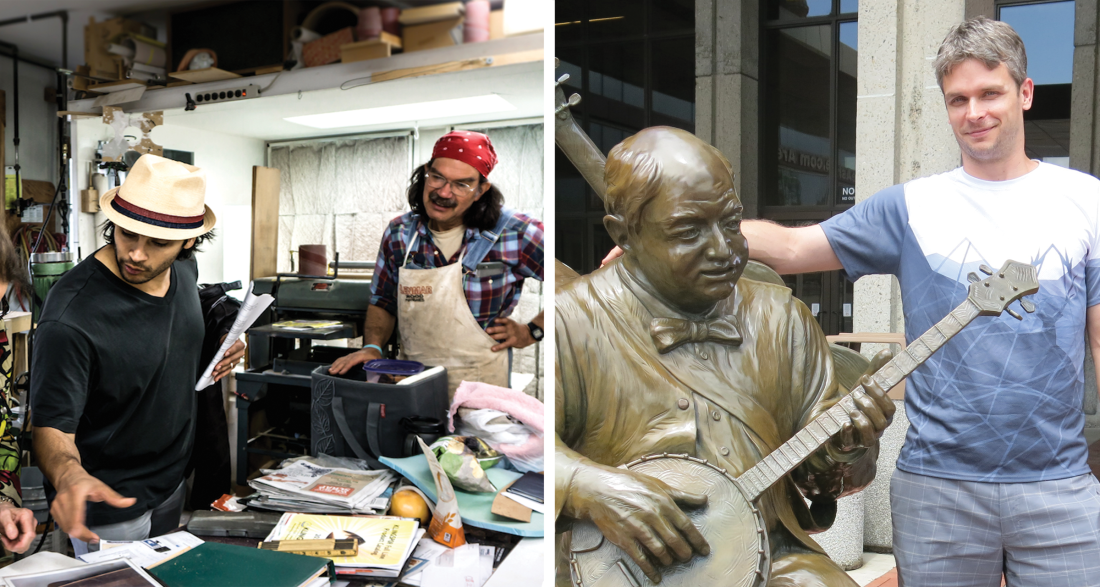Two new walking tours have stepped onto the scene. Asheville Music Tours offers a stroll through downtown, highlighting the city’s rich musical past, as well as celebrating its present-day achievements. Meanwhile, in the River Arts District, Asheville Art Studio Tours leads guests through a series of workspaces and galleries while sharing tales of the area’s former industrial days.
On the shoulder of giants
For the past 10 years, Dallas Taylor has been slightly obsessed with the idea of creating a music museum in Asheville. He has pitched the concept to numerous individuals and organizations in his attempt to turn his white whale into a reality. It was through this process that the idea evolved: If he couldn’t find the resources for a traditional brick-and-mortar museum, he’d bring local music history to the streets.
Taylor has spent many hours in the North Carolina Room at Pack Library in search of new insight and additional information on some of Asheville’s musical legends. This research led him to the likes of Wayne Erbsen‘s Native Ground Books & Music (a project focused on the preservation of Southern Appalachian music), the Madison County Art Council’s Blue Ridge Music Trails and books by local musician and storyteller David Holt.
“The tour will go from the father of Asheville music, Bascom Lamar Lunsford, to the father of country music, Jimmie Rodgers, to the father of bluegrass, Bill Monroe, and the father of electronic music, Bob Moog,” Taylor says.
Of the many stories imparted during the tour, some of Taylor’s favorites revolve around Rodgers, a legendary country singer. “He started out in Asheville, sleeping in a fire station,” Taylor says. “He befriended the fire chief’s son and was able to get a job with the police department.” Rodgers, however, wasn’t issued a gun and proved fairly useless to the department.
Fortunately for the singer, his musical talents would soon be discovered. In 1927, he broke through after a performance on WWNC radio, which broadcasted from the Flat Iron Building.
“I’m trying to build that foundation story,” Taylor says. “So that when people come here for musical events and festivals, they understand the shoulders of the giants that the music scene was built on.”
Asheville Music Tours is a 45-minute guided walk, currently offered on Wednesdays and Saturdays at 10 a.m. and 2 p.m. $10. ashevillemusictours.com
The industrial heart of the city
In the River Arts District, John Almaguer guides visitors through the neighborhood’s crafts and history. Since 2011, he’s been blowing glass at the North Carolina Glass Center and picking up on the background of the area. “This was originally the industrial heart of the city,” he says. “But when the River Arts District started to develop here in the 1980s, it wasn’t much of anything. The artists weren’t thinking of these [buildings] for retail at all. They were just great [places] for making art, because of the large space and cheap rent.”
Throughout the Asheville Art Studio Tours, Almaguer offers historical accounts of individuals and industries that have made a mark on the district, including the late John Payne (sculptor and previous owner of the Wedge Building), Moses and Caesar Cone (long-ago owners of the Asheville Cotton Mill) and the Biltmore Industries (which grew a reputation for quality craftsmanship — a fact Almaguer ties to the historical role of craft in the area).
The tours, however, are not merely anecdotal. During the walk, Almaguer takes guests into a series of studios. “There’s a diverse style of work and mediums offered,” he says. “Generally, we’ll be visiting a glass studio, a pottery studio and a few painting studios.”
The inspiration behind Asheville Art Studio Tours stemmed from ongoing talks with fellow artists. Very often, Almaguer says, visitors of the North Carolina Glass Center come in to see the glassblowing process but are also curious to learn where they should go next. “Some people are intimidated by the old buildings,” Almaguer notes. “There’s a mystery to them, and it can be a little unnerving. Others just aren’t sure where they can go.”
With Asheville Art Studio Tours, Almaguer hopes to offer new insights into an area that continues to see growth and change. “It’s a small, intimate experience,” he says. “You’re getting a chance to truly connect with the artists and their work and really have a more personal experience, not only with artists, but with your guide and with each other.”
Asheville Art Studio Tours is a two-hour walk offered at select times on Wednesdays, Fridays and Saturdays. $32 per adult. ashevilleartstudiotours.com




Shame that Dallas’ ‘white whale’ will remain so for varying priorities. Gwen Foster would do well to be included too, but,
beer
hotels
food
repeat